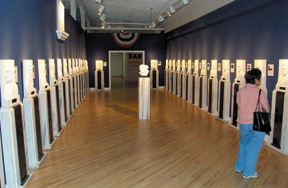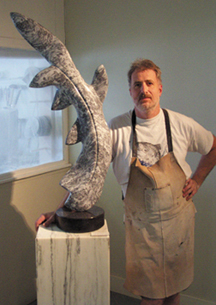Geotimes

On Exhibit
Marble Medley
Alma Hale Paty
The 100 exhibits at the Vermont Marble Museum, with its 27,000 square feet
of exhibit space, is believed to be the largest marble exhibit in the world
and encompasses art, geology and history. The inner artist in you will find
inspiration from watching a resident sculptor create art from a block of rough-hewn
marble, while the history buff will marvel at the array of historical photographs
showing the operations of the Vermont Marble Company at the turn of the 19th
century. And the hands-on activities of the new Earth Alive! exhibit are bound
to awaken the latent geologist in any visitor.
Art-ful setting
Norman Rockwell couldn't have painted a more idyllic American place than the
tiny town of Proctor. Located  seven
miles west of Rutland in central Vermont, Proctor boasts a church, bridge and
firehouse — all made of Vermont's luminous white marble, mined at the first
major quarry in Proctor, the Sutherland Falls Quarry. Across from the firehouse,
the Vermont Marble Museum (formerly known as the Vermont Marble Exhibit) is
housed in a former cutting facility of the Vermont Marble Company, founded in
1880 by the flamboyant and wily Col. Redfield Proctor. A Stonehenge-like portal
made of enormous blocks of rough-cut Danby white marble greets visitors entering
the grounds, while elegant, four-foot-high sculptures of Italian Carrara marble
convey a serene hello to visitors in the main lobby.
seven
miles west of Rutland in central Vermont, Proctor boasts a church, bridge and
firehouse — all made of Vermont's luminous white marble, mined at the first
major quarry in Proctor, the Sutherland Falls Quarry. Across from the firehouse,
the Vermont Marble Museum (formerly known as the Vermont Marble Exhibit) is
housed in a former cutting facility of the Vermont Marble Company, founded in
1880 by the flamboyant and wily Col. Redfield Proctor. A Stonehenge-like portal
made of enormous blocks of rough-cut Danby white marble greets visitors entering
the grounds, while elegant, four-foot-high sculptures of Italian Carrara marble
convey a serene hello to visitors in the main lobby.
The Vermont Marble Museum's Hall of Presidents
highlights marble's artistic side. Courtesy of the Vermont Marble Museum
The Hall of Presidents and the Marble Chapel showcase Vermont marble's use as
an artist's medium. The Hall of Presidents houses "bas-relief" portraits
of every president through George Bush (father). Taking more than 25 years to
complete, each portrait is carved from either Danby White or West Rutland White
Statuary marble, and each sits on a base of Champlain Black and Danby Montclair.
The steps, railing, baptismal and holy water fonts, walls and floor of the Marble
Chapel exhibit showcase the exquisite and colorful variety of Vermont's marbles,
including Swanton red for the walls and green Verde Antique for the floors.
Earth
Alive!
A new exhibit in progress at the museum called Earth Alive! showcases Earth's
dynamic history through a 160-degree mural, hands-on fossil activities, and
a fluorescent mineral display. Another exhibit in progress is an interpretive
one that is one-eighth mile long leading from the Museum to the Sutherland Falls
quarry. Visitors will be able to take their knowledge of geology and Vermont
marble and actually see where it all began — in Earth. Interpretive signs
will dot the trails by fall 2002.
From geology
to history
The geology section of exhibit room 8 showcases marble's composition, colors,
classification, varieties and geographic distribution. The composition exhibit
highlights the formation of marble from limestone, but also informs the visitor
that "commercial marbles" are those stones that can take a polish,
and that an igneous, silicious rock called serpentine is considered a marble
and is marketed as the Verde Antique marble.
Artist-in-residence Allen Dwight
poses with a marble sculpture made of West Rutland Marble. Courtesy of the Vermont
Marble Museum
While the historical uses of marble in sculpture and architecture are well understood,
a new exhibit focuses on marble's other, lesser-known uses. Called "CaCO3
— Mineral of Life," this new exhibit highlights marble's use as a
source of calcium carbonate, which is used in everyday products such as cement,
antacids, rubber, stucco, toothpaste and pottery. Cosponsored by the mining
company OMYA Inc., this new exhibit offers the visitor an insight into how humans
depend on minerals for consumer necessities.
One of the most interesting aspects of the Vermont Marble Museum concerns the
disparate worlds of immigration and photography. In the late 1800s, the Vermont
Marble Company had an office at Ellis Island, where company officials would
greet disembarking immigrants with questions in Italian, Welsh or Polish, asking
them, "Stonecutter? Quarryman? Carver?" Thus many immigrants with
quarrying experience in the Old World were hired for their experience in the
New World and brought to the quarries in Vermont. At the same time, the Vermont
Marble Company hired a staff photographer to document the period from 1890 to
1935. According to Pye, "The Museum has more than 40,000 glass negatives,
some 12 inches by 12 inches, of the Vermont Marble Company in operation. The
majority of these negatives show the company's immigrant workforce." By
utilizing these photos and other documentation, the Museum plans to open a new
exhibit in 2003, "Immigrant History of the Vermont Marble Company,"
dedicated to the contributions of immigrants to the Vermont Marble Company and
to the country. Plans call for an interactive database for researching immigrant
heritage.
From fine art to geology to American history, the Vermont Marble Museum offers
the visitor a unique opportunity to learn how these three disparate subjects
are connected — through marble.
Details, Details:
Location: 52 Main Street, Proctor, Vermont 05765
Tel: 802/459-2300
Season: May -October
Hours: 9am to 5:30pm 7days a week
Admission: Adults $6, Seniors $4, Teenagers (15-18) $3, Children under 15 free.
Discount admission available online.
Gift shop carries marbles utensils and objects, and special orders for kitchen
and fireplace marble are available.
To plan your route throughout the exhibits, it is best to take the 11 minutes
to view the video about "The Legacy of Vermont Marble." This succinct
film provides information about the Vermont Marble Company, which started the
Vermont Marble Exhibit in 1933, and its immigrant workforce.
Paty is founder and president
of A Capital Resource, a Washington-based consulting firm specializing in mineral
resource issues and education.
 seven
miles west of Rutland in central Vermont, Proctor boasts a church, bridge and
firehouse — all made of Vermont's luminous white marble, mined at the first
major quarry in Proctor, the Sutherland Falls Quarry. Across from the firehouse,
the Vermont Marble Museum (formerly known as the Vermont Marble Exhibit) is
housed in a former cutting facility of the Vermont Marble Company, founded in
1880 by the flamboyant and wily Col. Redfield Proctor. A Stonehenge-like portal
made of enormous blocks of rough-cut Danby white marble greets visitors entering
the grounds, while elegant, four-foot-high sculptures of Italian Carrara marble
convey a serene hello to visitors in the main lobby.
seven
miles west of Rutland in central Vermont, Proctor boasts a church, bridge and
firehouse — all made of Vermont's luminous white marble, mined at the first
major quarry in Proctor, the Sutherland Falls Quarry. Across from the firehouse,
the Vermont Marble Museum (formerly known as the Vermont Marble Exhibit) is
housed in a former cutting facility of the Vermont Marble Company, founded in
1880 by the flamboyant and wily Col. Redfield Proctor. A Stonehenge-like portal
made of enormous blocks of rough-cut Danby white marble greets visitors entering
the grounds, while elegant, four-foot-high sculptures of Italian Carrara marble
convey a serene hello to visitors in the main lobby.

